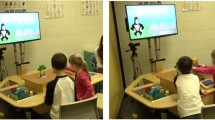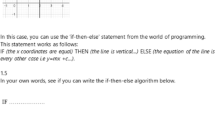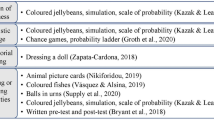Abstract
This paper sits within the research on the affordances of new technologies in the mathematics classroom and focuses on a specific feature that is available in dynamic geometry environments, i.e. measuring tools, within the context of conjecturing and proving in open geometry problems. We develop a classification of different modalities of measuring, based on our previous work on dragging. The modalities are illustrated through the analysis of 15–16 year-old students’ proving processes, which focuses on how these modalities relate to the moves between the spatio-graphical field and the theoretical field and may either support or hinder the proving process. The classification of the modalities of measuring enables researchers to access students’ cognitive processes and teachers to be aware of the different possible uses and interpretation of measuring, giving them tools to support students when difficulties arise.










Similar content being viewed by others
Notes
This discussion is referred to Cabri because it is the software we used in our research but similar issues could apply to other dynamic geometry environments.
Measurements are updated in real time as the figure is dragged.
Boieri (1995) refers to Cabri I but the method of computation of measurements performed by the subsequent versions of Cabri is still the same.
It can be verified (Boieri 1995) in practice that the relative uncertainty for measurements in Cabri is less than 2%, and it can be reduced according to the choice of the measurement unity.
The same thing may happen with other geometric properties, as for example angles in circles, Pythagoras theorem, etc.
It is interesting to notice that this problem sits within the bigger issue of the trust that users (students in particular) normally have in what is calculated/produced/shown by the computer.
Every theorem is a statement B for which there is another statement A such that B is a logical consequence of A.
We use the word ‘field’, rather than ‘level’ as originally used by (Laborde 1998), in order to stress the fact that spatio-graphical and theoretical field may coexist.
For more information on the methodology of the project see (Olivero 2002).
Here and elsewhere we refer to the description of the different dragging modalities given in (Arzarello et al. 1998a).
The students of a Liceo Psico-Pedagogico attend 4 mathematics classes per week. This type of school does not have a strong mathematic-scientific orientation.
The same sort of conflict could be originated with younger students by using other measuring tools, as for example a ruler.
In this case, not only measurements but also the use of constructions to check a property.
Similarly to the previous example, also in this case the figure on the screen is not a ‘constructed’ square.
The students of a Liceo Scientifico attend 5 mathematics classes per week. This type of school has a strong mathematic-scientific orientation.
References
Arsac, G., Germain, G., & Mante, M. (1988). Problème Ouvert et Situation—Problème. Academie de Lyon: IREM.
Arzarello, F. (2000). Inside and outside: spaces, times and language in proof production. In T. Nakahara & M. Koyama (Eds.), Proceedings of the 24th Conference of the International Group for the Psychology of Mathematics Education (Vol. 1, pp. 23–38). Hiroshima, Japan.
Arzarello, F., Gallino, G., Micheletti, C., Olivero, F., Paola, D., & Robutti, O. (1998a). Dragging in Cabri and modalities of transition from conjectures to proofs in geometry. In A. Olivier & K. Newstead (Eds.), Proceedings of the 22nd Conference of the International Group for the Psychology of Mathematics Education (Vol. 2, pp. 32–39). Stellenbosh, South Africa.
Arzarello, F., Micheletti, C., Olivero, F., Paola, D., & Robutti, O. (1998b). A model for analysing the transition to formal proofs in geometry. In A. Olivier & K. Newstead (Eds.), Proceedings of the 22nd Conference of the International Group for the Psychology of Mathematics Education (Vol. 2, pp. 24–31). Stellenbosh, South Africa.
Arzarello, F., Olivero, F., Paola, D., & Robutti, O. (2002). A cognitive analysis of dragging practises in Cabri environments. Zentralblatt fur Didaktik der Mathematik, 34(3), 66–72.
Balacheff, N. (1987). Processus de preuve et situation de validation. Educational Studies in Mathematics, 18, 147–176.
Bartolini Bussi, M., & Boni, M. (2003). Instruments for semiotic mediation in primary school classrooms. For the learning of mathematics, 23(2), 15–22.
Baulac, Y., Bellemain, F., & Laborde, J. M. (1988). Cabri-Géomètre, un logiciel d’aide à l’apprentissage de la géomètrie. Logiciel et manuel d’utilisation. Paris: Cedic-Nathan.
Boero, P., Garuti, R., & Mariotti, M. A. (1996). Some dynamic mental processes underlying producing and proving conjectures. In L. Puig & A. Gutierrez (Eds.), Proceedings of the 20th Conference of the International Group for the Psychology of Mathematics Education (Vol. 2, pp. 121–128). Valencia, Spain.
Boieri, P. (1995). La misura in Cabri: Quaderni di CabrIrrsae.
Chazan, D. (1993). High school geometry students’ justification for their views of empirical evidence and mathematical proof. Educational Studies in Mathematics, 24, 359–387.
Guala, E., & Boero, P. (1999). Time complexity and learning. Annals of the New York Academy of Sciences, 879, 164–167.
Guin, D., & Trouche, L. (1999). The complex process of converting tools into mathematical instruments: The case of calculators. International Journal of Computers for Mathematical Learning, 3, 195–227.
Hadas, N., Hershkowitz, R., & Schwarz, B. (2000). The role of contradiction and uncertainty in promoting the need to prove in Dynamic Geometry environments. Educational Studies in Mathematics, 44(1–3), 127–150.
Hanna, G. (1996). The ongoing value of proof. In L. Puig & A. Gutierrez (Eds.), Proceedings of the 20th Conference of the International Group for the Psychology of Mathematics Education (Vol. 1, pp. 21–33). Valencia, Spain.
Hoyles, C., & Healy, L. (1999). Linking informal argumentation with formal proof through computer-integrated teaching experiments. In O. Zaslavsky (Ed.), Proceedings of the 23rd Conference of the International Group for the Psychology of Mathematics Education (Vol. 3, pp. 105–112). Haifa, Israel.
Jones, K. (2000). Providing a foundation for deductive reasoning: Students’ interpretations when using dynamic geometry software and their evolving mathematical explanations. Educational Studies in Mathematics, 44, 55–85.
Kaput, J., & Schorr, R. (2002). Changing representational infrastructures changes most everything: The case of SimCalc, Algebra & Calculus. In K. Heid & G. Blume (Eds.), Research on the Impact of Technology on the Teaching and Learning of Mathematics.
Laborde, C. (1998). Relationship between the spatial and theoretical in geometry: The role of computer dynamic representations in problem solving. In J. D. Tinsley & D. C. Johnson (Eds.), Information and communications technologies in school mathematics (pp. 183–195). London: Chapman & Hall.
Laborde, C. (2002). Integration of technology in the design of geometry tasks with Cabri-geometry. International Journal of Computers for Mathematical Learning, 6(3), 283–317.
Laborde, C. (2003). Technology used as a tool for mediating knowledge in the teaching of mathematics: The case of Cabri-Geometry. Paper presented at the ATCM 2003.
Laborde, C. (2004). The hidden role of diagrams in pupils’ construction of meaning in geometry. In J. Kilpatrick, C. Hoyles & O. Skovsmose (Eds.), Meaning in mathematics education (pp. 1–21). Dordrecht: Kluwer Academic Publishers.
Lagrange, J. B., Artigue, M., Laborde, C., & Trouche, L. (2001). A meta study on IC technologies in education. Towards a multidimensional framework to tackle their integration. In M. van den Heuvel-Panhuizen (Ed.), Proceedings of the 25th Conference of the International Group for the Psychology of Mathematics Education (Vol. 1, pp. 111–122). Utrecht, The Netherlands.
Mariotti, M. A. (2002). Influence of technologies advances on students’ maths learning. In L. English, M. Bartolini Bussi, G. Jones, R. Lesh, & D. Tirosh (Eds.), Handbook of international research in mathematics education (pp. 695–721). Mahwah, NJ: Lawrence Erlbaum Associates.
Marrades, R., & Gutierrez, A. (2000). Proofs produced by secondary school students learning geometry in a dynamic computer environment. Educational Studies in Mathematics, 44, 87–125.
Noss, R. (1995). Thematic chapter: Computers as commodities. In A. DiSessa, C. Hoyles & R. Noss (Eds.), Computers and exploratory learning (pp. 363–381). Berlin: Springer-Verlag.
Olivero, F. (2002). The proving process within a dynamic geometry environment. (Doctoral thesis). Bristol: University of Bristol, ISBN 0-86292-535-5.
Olivero, F., & Robutti, O. (2001). Measuring in Cabri as a bridge between perception and theory. In M. van den Heuvel-Panhuizen (Ed.), Proceedings of the 25th Conference of the International Group for the Psychology of Mathematics Education (Vol. 4, pp. 9–16). Utrecht, The Netherlands.
Olivero, F., & Robutti, O. (2002). An exploratory study of students’ measurement activity in a dynamic geometry environment. In Proceedings of CERME2 (Vol. 1, pp. 215–226). Marianske Lazne, CZ.
Paola, D., & Robutti, O. (2004). Experimenting and explaining quantity variations to learn functions with Cabri-Géomètre. Paper presented at the Cabriworld 2004, Rome.
Perkins, D. N. (1985). The fingertip effect: How information-processing technology changes thinking. Educational Researcher, 14(7), 11–17.
Rav, Y. (1999). Why do we prove theorems? Philosophia Mathematica III, 7, 5–41.
Sinclair, M. P. (2003). Some implications of the results of a case study for the design of pre-constructed dynamic geometry sketches and accompanying materials. Educational Studies in Mathematics, 52(3), 289–317.
Sutherland, R., & Balacheff, N. (1999). Didactical complexity of computational environments for the learning of mathematics. International Journal of Computers for Mathematical Learning, 4, 1–26.
Talmon, V., & Yerushalmy, M. (2004). Understanding dynamic behavior: Parent–child relations in dynamic geometry environments. Educational Studies in Mathematics, 57, 91–119.
Vadcard, L. (1999). La validation en géomètrie au Collège avec Cabri-Géomètre: mesures exploratoire et mesures probatoires. Petit X(50), 5–21.
Verillion, P., & Rabardel, P. (1995). Cognition and artifacts: a contribution to the study of thought in relation to instrumented activity. European Journal of Psychology of Education, 10, 77–101.
Acknowledgments
Research program supported by MIUR, Università di Torino and Università di Modena e Reggio Emilia (PRIN Contract n. 2005019721), and by an ESRC studentship at the University of Bristol.
Author information
Authors and Affiliations
Corresponding author
Rights and permissions
About this article
Cite this article
Olivero, F., Robutti, O. Measuring in dynamic geometry environments as a tool for conjecturing and proving. Int J Comput Math Learning 12, 135–156 (2007). https://doi.org/10.1007/s10758-007-9115-1
Received:
Accepted:
Published:
Issue Date:
DOI: https://doi.org/10.1007/s10758-007-9115-1




